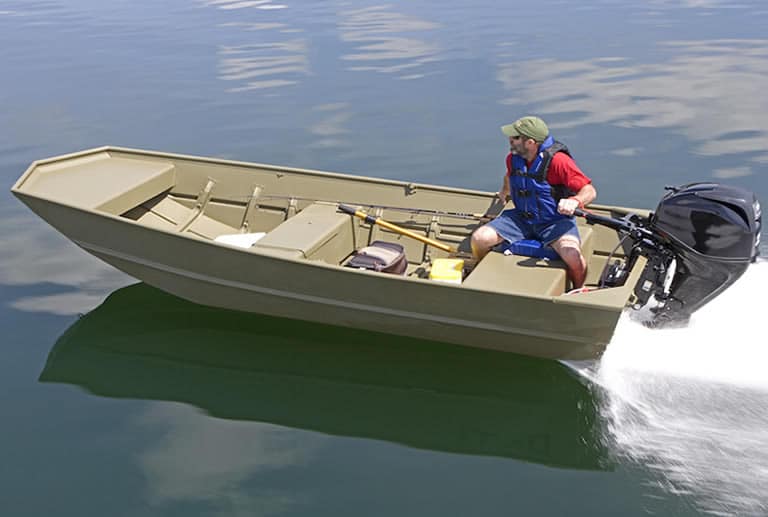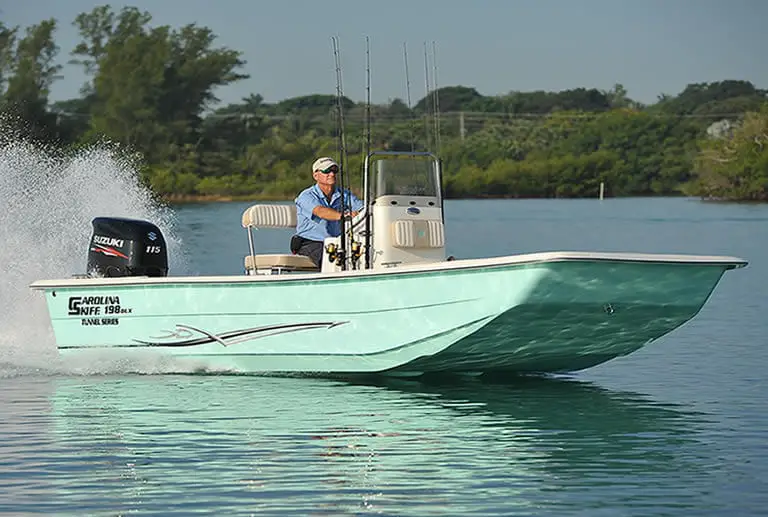Contents
- How To Drive A Flat Bottom Boat
- Driving Boats With A Flat Hull vs Other Hull Types
How To Drive A Flat Bottom Boat
Most flat bottom boats can be steered and driven by an outboard motor, oars, paddles or a pole depending on their size.
The techniques used to drive them are the same as for any other boat but the flat hull design means they ride on the water instead of slicing through it.
This has both advantages and disadvantages.
The mechanics of driving a flat bottom boat
The first thing to remember is that you are best not operating any type of flat bottom boat in adverse weather conditions.
Flat bottom boats are not designed for rough water. They perform best in calm water.

When water becomes choppy a flat-bottomed can become unstable and in adverse weather conditions it becomes downright dangerous to be in one.
Of course there are ways to stabilize the boat as we outlined here but for the most part flat bottom boats are designed to be used in calm water and calm weather.
The flat bottom hull on boats such as skiffs, Jon boats and scows, will cause this type of boat to ride on the water rather than slicing through it the way other hull types do.
Although this makes the boat less stable in challenging weather it makes for a very comfortable and pleasant ride, even at high speed, on calm waters.
A Jon boat is a very popular flat bottom utility boat used extensively for shallow waterway utility work, fresh water fishing and hunting.
It has a very shallow draft and almost completely flat hull and is very easy to drive.
As you can see in the video below this boat performs very well at speed on calm water using an outboard tiller steered engine.
The bow of the boat lifts out of the water as the boat initially accelerates. As speed is maintained the boat bow will drop so most of the boat sits on the surface of the water.
However, the front end of the Jon boat will still be lifted slightly out of the water which stops spray from entering the boat as it moves forward at speed.
The spray from the backwash generated by the outboard motor is kept away from the operator and forced to each side of the transom and backwards.
Because there is very little friction from the water, as you would get with a v-hull slicing through the water instead of sitting on it, the ride is exceptionally comfortable.
Although, this unique design gives for a pleasant and comfortable ride on calm water attempting to drive this type of boat on choppy water in windy conditions creates the completely opposite effect.
The flat hull offers no stability in choppy waters, the way a v-hull would, and the squared-off front will allow waves to crash over the bow and into the boat.
On other types of flat bottom boat you can expect the same driving experience, though some boat enthusiasts complain that on certain skiffs you can expect to get a wet even in only slight waves.
How to drive a flat bottom boat with an outboard motor
Driving any boat via an outboard motor is not complicated.
Flat bottom boats with outboard motors come in two distinct steering types however.
These steering types are:
- Tiller steer
- Steering wheel
Tiller Steer
Most smaller flat bottom boats, such as Jon boats, will be operated by a tiller motor (if they are equipped with an outboard motor at all).
Outboard tiller motors have an electric start that is triggered via a pull string, like old school lawn mowers.
They are very easy to start as you can see in the video below.
A tiller steer type of outboard motor is equipped with a handle that has an accelerator used to increase and decrease speed as needed.
The handle also acts as a means for controlling the direction of the rudder. It is known as a “tiller steer”.
To use turn the boat using the tiller steer simply turn the handle to the left or right to turn the boat in the desired direction.
Bear in mind that when you turn the tiller handle to the right the boat will move left and when you turn the tiller handle to the left the boat will move right.
So, to move in the boat direction you want it to go, you must turn the tiller handle in the opposite direction as shown in the video below.
How to use a tiller motor
Steering wheel
Larger flat bottom boats, such as a large skiff, will be propelled by an outboard motor but will not be tiller steered.
Instead such a larger flat-bottomed vessels will be equipped with a steering wheel to make the boat easier to maneuver.
The difference between using a tiller steer mechanism and a steering wheel is in its operation.
Using a tiller means you need to turn the handle in the opposite direction to which you want the boat to move while a steering wheel operates the same as a motor vehicle.
With a steering wheel you simply turn the wheel in the same direction you want the boat to move.
There are some additional key points you need to keep in mind when using a boat with a steering wheel though and these are outlined in the video below.
Tips for steering a boat
How to drive a flat bottom boat with oars
Propelling a flat bottom boat, or any boat for that matter, with oars is a different experience to using an outboard motor and requires a different technique for steering.
Just as we outlined in the article can you row a Jon boat it is not only possible to use oars on a flat bottom boat but many boat owners prefer this method of propulsion.
Anglers will often use oars or paddles when approaching their chosen fishing spot as engine noise and water turbulence can frighten away the fish.
Likewise duck hunters will do the same.
Additionally, duck hunters will often steer their boats very close to shore where the water depth is only a few inches.
Although the flat bottom shallow draft on the boat makes this possible obviously using an outboard motor is not possible in such shallow water and therefore oars or paddles are preferred.
Rowing technique
Rowing a flat bottom boat involves exactly the same technique employed to row any kind of boat.
Review the video below for full instructions on how to row a boat.
How to drive a flat bottom boat with paddles
Paddles are only appropriate in small boats.
Obviously the boat width must not be so wide that it is difficult for the paddle to reach into the water at both the port and starboard sides of the boat.
There are two kinds of paddles used.
They are:
- Two sides paddles
- Single paddle
Two sided paddles are the favored means of propulsion for kayaks while a single paddle is the preferred means of propulsion for canoes.
Most small flat bottom boat owners will use the single paddle approach used on canoes.
Paddle technique
Using a single paddle in a small flat bottom boat is very easy as demonstrated in the video below.
How to drive a flat bottom boat with a pole
Using a pole to propel and steer a flat bottom boat is extremely easy if a little physically demanded.
Sandola boats are propelled and steered this way in Venice (unlike gondolas which used a single oar).
However, it is only possible in shallow waters.
As flat bottom boats are designed to traverse shallow water it is not unusual to see a pole in a flat bottom boat such as a Jon boat or skiff.
However, as a means of sole propulsion and steering a pole is insufficient unless the entire waterway being traversed is very shallow.
Most bodies of water, no matter how shallow, will have deep parts where a pole would be unable to reach the bottom. This would leave a boat stranded if it ventured into that area with only a pole as a means of propulsion.
On flat-bottomed working boats a pole is often used to help push the boat away from obstacles or away from the shore or when using the engine is not appropriate.
Fundamentals of poling
Driving Boats With A Flat Hull vs Other Hull Types
There is no difference between any boat type when using manual methods for propulsion and steering.
The techniques used will always be the same.
Likewise, when using an outboard motor for driving a flat bottom boat the methods employed will be the same also. However, the boat will react differently.
As outlined above the flat hull design on these boat types mean they ride on the water while v-hull, semi-v and rounded hulls slice through the water.
This gives a different experience for passengers.
In calm water a fat-bottomed boat gives an exceptionally smooth and comfortable ride at speed while boats with other hull types are less comfortable and create a more bumpy ride.
Driving a flat bottom V-drive
As flat bottom boats are very comfortable at speed it comes as no surprise that there are flat-bottomed speed boats.
Though a v-drive flat bottom boat’s sides sit closer to the waterline than other boat types, due to its shallow draft flat-bottomed hull, it is driven like any other speed boat.
A steering wheel gives you full control over the direction of the boat though you will want to aim straight at high speed as attempting to turn will probably tip the boat.
In the video below you can see how the the v-drive boats skip on top of the water. This is because their flat bottoms and shallow drafts eliminate the drag that would created on v-hull and other hull type boats.
For tips on driving fast on a flat bottom boat, review the video below.

